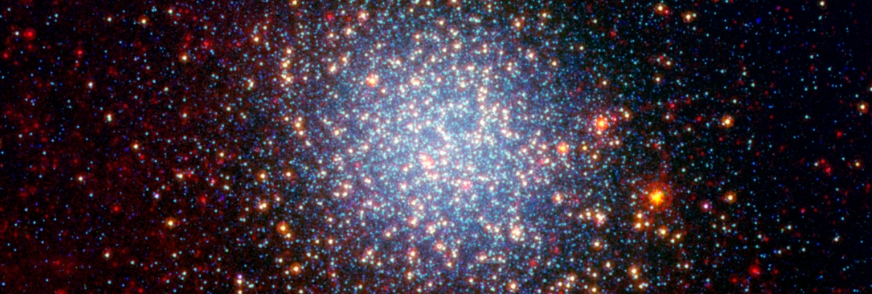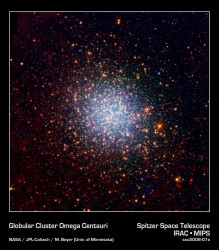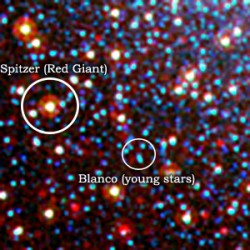By combining ground-based optical observations with space-borne infrared images from Spitzer, an incredible new view of mysterious Omega Centauri has been revealed. Astronomers have had a hard time identifying what type of galaxy Omega Centauri actually is, so any new information on the cluster of millions of stars is needed. By combining observations in different wavelengths, stars of different ages are highlighted, possibly aiding our understanding about the origins of Omega Centauri and answer the question: Why is this galaxy so strange?
As discussed in an article last week, Omega Centauri is of particular interest to astrophysicists. Over the years this strange collection of stars has been classified as a single star (by Ptolemy), a nebula (by Halley in 1677) and a globular cluster (by Herschel in the 1830’s). Now it is believed that this dwarf galaxy may be a survivor of an ancient collision with the Milky Way which stripped away its outermost stars. This is why it may look like a globular cluster now, but doesn’t have globular cluster characteristics. For a start Omega Centauri is too big (ten times bigger than the largest globular clusters) and it contains stars of many generations (globular clusters usually contain one generation). Recent observations also show a very fast rotating galactic core, revealing the presence of an intermediate-size black hole… the missing link connecting stellar black holes with supermassive black holes. Exciting stuff.
Putting the scientific implications to one side for now, I can’t help but stare at this stunning view of this interesting cluster of star systems. I’m used to monochromatic images of space with some false-colour thrown in for good measure; this image seems to be different. Very quickly we are able to gain an insight to the dispersion of star generations, just by looking at the image. A quick glance shows the majority of young stars are clustered toward the middle (the blue stars), older red giants located around the outside of the galaxy (the red/yellow stars).
According to the NASA news release, where green and red dots overlap, yellow dots appear. These are NASA Spitzer Space Telescope stars observed in infrared. We know that these emissions come from old, large and dusty stars, the red giants. The blue dots are younger stars, much like our Sun, as observed in optical and near-infrared wavelengths by the National Science Foundation’s Blanco 4-meter telescope at Cerro Tololo Inter-American Observatory in Chile. I’ve included a little section from the main image with the two types of star ringed and annotated (pictured).
These new Spitzer observations show very little dust around any of the dimmest red giants and the space between the stars also does not seem to contain much dust (as interstellar dust would glow infrared radiation as nearby stars heat it). Astronomers have concluded that any dust within the cluster is quickly destroyed or lost from the galaxy.
Source: NASA




It’s mysterious because Omega Centauri has been very difficult to classify over the years. For a long time astronomers thought it was a larger globular cluster, but now they think it’s a dwarf galaxy missing it’s outermost stars. Plus, an intermediate-size black hole might be in the center… it’s been a real forensic puzzle, but all the clues are slowly coming together…
Cheers, Ian
Beautiful photo, are you able to tell how far apart those stars are, they seem to be almost touching, one serious place to not want to be, but gorgeous to observe
Why it is mysterious?